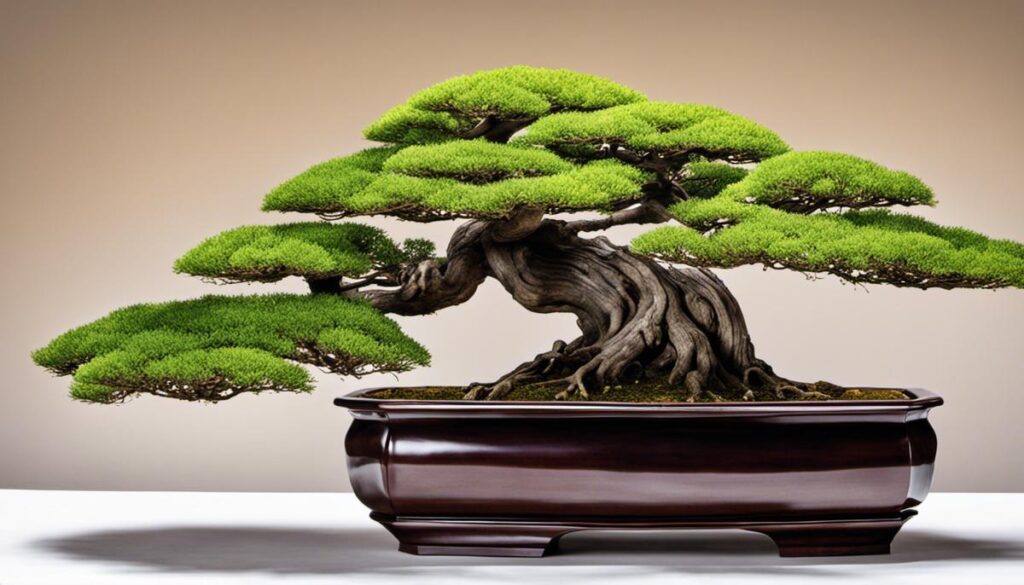The art of bonsai, a Japanese technique of growing miniature trees in pots, is steeped in centuries’ worth of culture, tradition and aesthetic principles. One of the most distinctive styles of bonsai is the Shakan, known for its unique, slanting form.
This guide will delve deep into the captivating world of Shakan-style bonsai trees, beginning with an understanding of its roots in Japanese aesthetics, to the meticulous process of crafting these miniature masterpieces, and ultimately, their diligent care and maintenance.
To further inspire, we’ll journey through a visual tour of stunning Shakan bonsai trees that exemplify the exceptional beauty of this revered style.
Understanding the Shakan Style
The Essential of Shakan Style
Under the umbrella of the diverse world of bonsai styles, the Shakan style takes a significant place. This style, which prominently features slanted bonsai trees, artistically portrays the resilience of trees in nature against severe weather conditions. The trees portrayed in this style are typically shown at an angle anywhere between 60 to 45 degrees from the vertical. Their defining characteristic is the slanted trunk that seems to speak volumes about the tree’s struggle against the elements.
Aesthetics Behind Shakan Style
Traditional Japanese aesthetics heavily inspire the Shakan style. It represents the ability of nature to overcome challenges and the survival capacity of living things despite hardships. The slant of the tree is emblematic of the strength and versatility of life. As such, the Shakan style is admired for its portrayal of not just physical beauty, but emotional depth as well.
Distinctiveness from Other Bonsai styles
Despite all bonsai styles having the underlying principle of representing nature in miniature, what sets the Shakan style apart is its slanting depiction. While a vertically straight tree might symbolize firmed groundedness and stability, a slanting tree is reflective of the struggles and resilience in life. Where most bonsai styles might aim to represent perfect shapes, the Shakan style highlights the beauty in imperfection, the elegance in slants. The Shakan style strikes the balance between aesthetics, representation of nature, and the underlying philosophy of resilience.
Shaping of Shakan Bonsai Trees
Shaping a bonsai into the Shakan style requires meticulous focus and a deep understanding of the tree’s natural inclinations. The artist must first choose a tree species that can adapt to the conditions necessary to achieve the unique slant. Afterward, the tree is carefully pruned and wired to slowly incline the trunk while fostering the growth of branches in the appropriate directions. The maintenance of the Shakan style tree is an ongoing process, requiring dedication and persistence.
The Diversity Within Shakan Style
While the slant is the defining factor of the Shakan style, the degree and direction of the slant can vary. Some trees exhibit a more severe slant than others, and the slant can be to the left or right. Similarly, the shape and arrangement of the branches also vary, mirroring the diversity found in nature itself. Thus, there is significant creativity and modulation within the Shakan style, each tree a unique piece of art.
Cultural Significance of Shakan Style
In Japanese culture and notes on aesthetics, the Shakan style holds substantial value. Its sovereign beauty and symbolic expression of resilience and adaptability have made it not just a gardening style but also a philosophical outlook towards adversity. It is often used symbolically to inspire strength and hope, a testament to the saying that the beauty of nature lies in its infinite capacity for survival.
Understanding the Significance of the Shakan Style
The Shakan Style in the Bonsai art form is much more than just a design. The unique slant of the tree speaks volumes about endurance and the ability to flourish in spite of adversities. A testimony to survival in harsh conditions, the slanting stance represents the tree’s determination and resilience, adding to the therapeutic and aesthetic significance of this bonsai style.
The Art of Crafting Shakan-Style Bonsai Trees
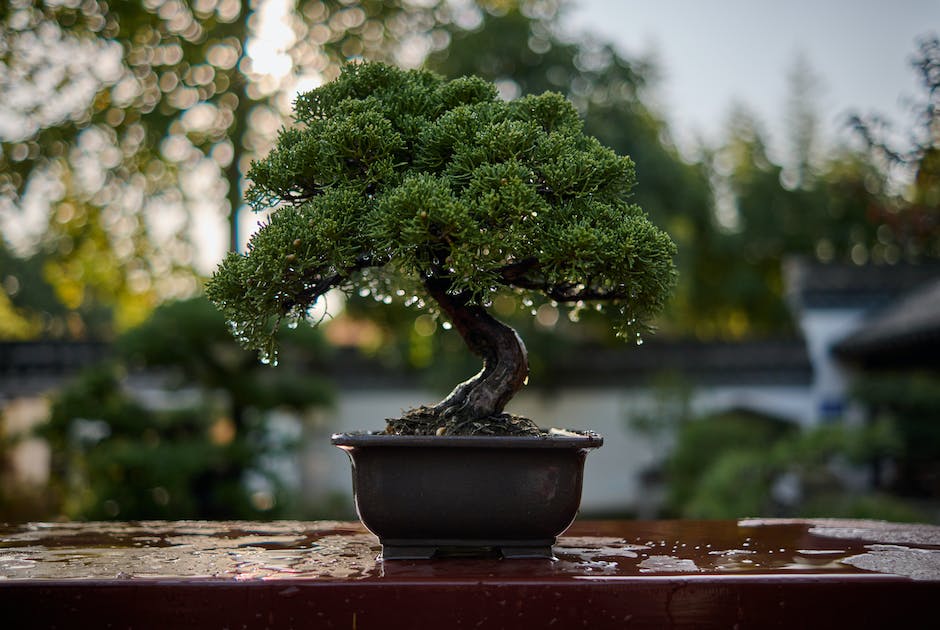
Selection of an Ideal Candidate for a Shakan Style Bonsai
Crafting a standout Shakan style bonsai involves choosing the right tree carefully. Key characteristics to look for include a robust root system and a main trunk that leans between 60 to 80 degrees. Some of the preferred tree species for this slanting style are Juniper, Pine, and Maple, although virtually any hardy tree with a suitable branching pattern can work well with the Shakan style of bonsai.
Trimming a Shakan Bonsai Tree
The trimming process of Shakan style bonsai trees specializes in creating an overall balanced aesthetic. Begin by removing any unnecessary branches that detract from the slanting style, taking care not to leave large scars that might disrupt the tree’s visual flow. Remember to trim branches starting from the bottom and working your way up, leaving stronger branches at the bottom, gradually getting smaller towards the top.
The Art of Wiring a Shakan Bonsai Tree
Wiring is a crucial step in the creation of Shakan style bonsai trees, serving to control the direction and position of the tree branches. Start by using an appropriately sized wire to gently bend the branches into the desired slanting direction. Take special care not to wire too tight, as it could damage the bark or inhibit growth. The process can be done at any season but is most effective during the late autumn or winter when the trees are in a dormant state.
Pruning a Shakan Bonsai Tree to Perfection
Pruning further refines the shape of your Shakan bonsai and encourages a balanced growth pattern. It is significant to prune your bonsai tree regularly to maintain its shape and health. The primary goal when pruning a Shakan style bonsai is to create a natural slanting look, meaning that the tree should lean to one side. All branches that do not contribute to this aesthetic should be pruned.
Popular Tree Types for Shakan Style Bonsai
There are several tree species that are particularly suited to the Shakan style bonsai, largely due to natural growth patterns and aesthetic appeal. Juniper trees make excellent choices with their inherent flexibility and durability, while Pine trees are favored for their firm structure and attractive bark. Another preferred species is the Maple tree, beloved for its seasonally varying leaves. Each species contributes a unique feature to the Shakan style bonsai, providing a breadth of possibilities for enthusiasts.
Maintenance and Care for Shakan Bonsai Trees
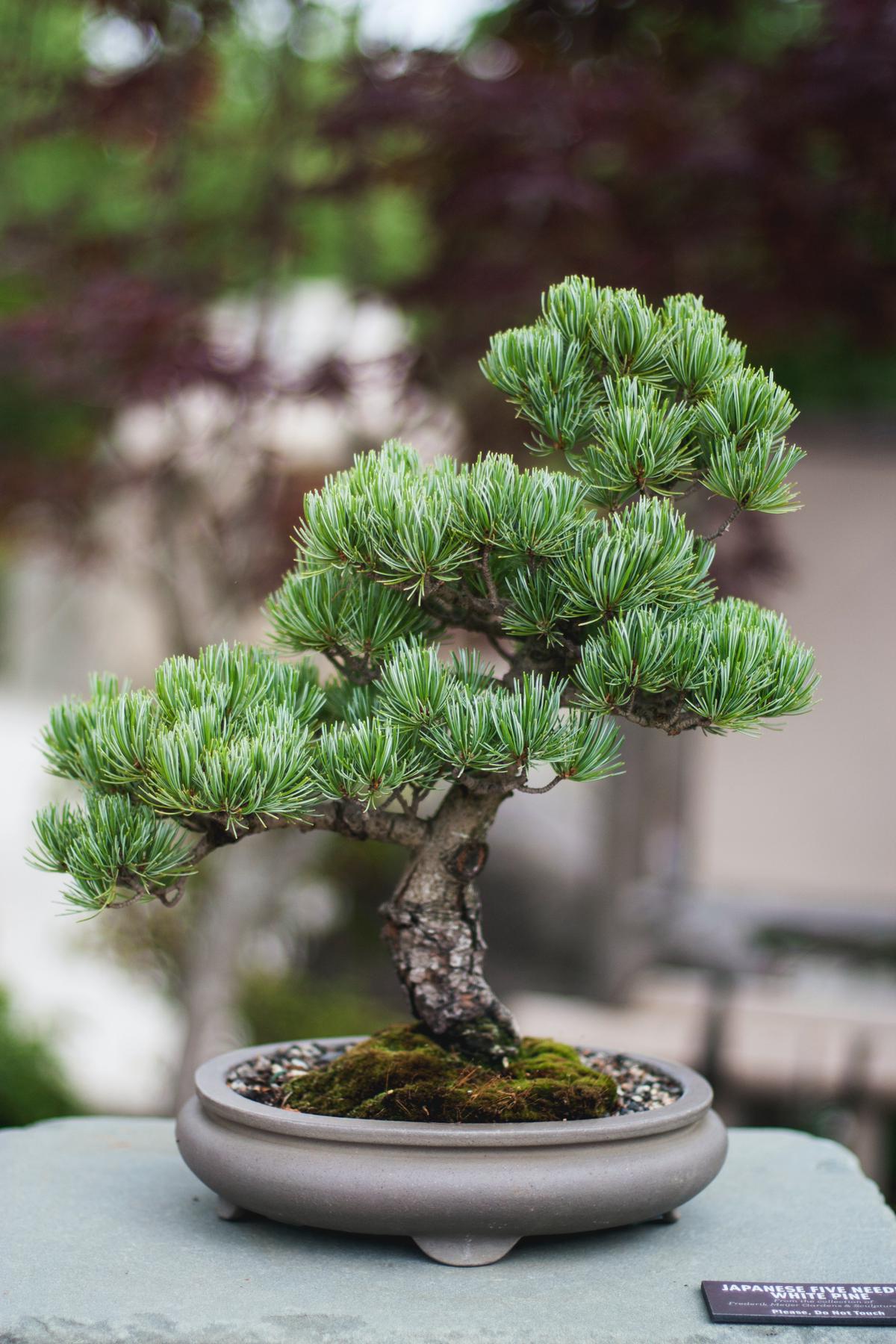
Understanding The Art of Shakan Style Bonsai
Bonsai, a highly respected art form born out of Japan, boasts its own distinct styles, one of the most notable being the Shakan style. The essence of this style lies in creating an angled, almost diagonal stance of the tree—a deviation from traditional Bonsai techniques. This slanting technique endows the bonsai with the illusion of growing out from a steep slope or cliff, narrating a story of survival against the elements.
Watering Regimen for Shakan Bonsai Trees
Watering regimen for Shakan Bonsai trees needs a delicate balance. Overwatering or underwatering both can cause harm to the trees. The Shakan style tree should be watered when the soil appears slightly dry. It is important to soak the entire root system, which may mean watering multiple times until the water comes through the drainage hole.
The Importance of Fertilizing Shakan Style Bonsai
Just like any other plant, Bonsai trees also need nutrients for their growth and health. A slow-release organic fertilizer should be used for Shakan style bonsai trees. The trees need to be fertilized every 1-2 weeks during the growing season and every 4-6 weeks during the winter.
Repotting of The Shakan Bonsai Trees
Repotting is a crucial element in the maintenance of Shakan Bonsai trees as it encourages the growth of a healthy root system. Typically, Shakan Bonsai need to be repotted every two to five years, but the exact timing will depend on the age and species of the tree. The best time to repot a Shakan bonsai is late winter or early spring.
Pest Control and Disease Prevention
Shakan Bonsai trees, like all bonsai trees, are susceptible to pests and diseases. Common pests include aphids, spider mites, and scale insects. It’s critical to regularly inspect the tree for any signs of pests and use an appropriate pesticide if needed. Diseases, on the other hand, can be fungal, bacterial, or viral. Proper maintenance can prevent many diseases, but if a tree does become infected, it should be isolated and treated with an appropriate fungicide, bactericide, or virucide.
Pruning and Shaping Shakan Bonsai Trees
Pruning is the primary method of training and shaping Shakan bonsai trees. This involves removing unwanted branches and foliage with a sharp, clean tool. The goal is to maintain the tree’s slanted form and enhance its aesthetic appeal. Wire shaping may also be used to guide growth and is typically left in place for about a year before removal.
Location and Sunlight Needs
Sunlight plays a vital part in the growth of the Shakan Bonsai tree. A Shakan Bonsai prefers bright, indirect sunlight as direct sunlight can scorch the leaves. The tree must also be protected from strong winds as this can damage the delicate branches and leaves, impacting the overall visual aesthetic of the Shakan style.
Bonsai trees are a pinnacle of serenity and tranquility, embodying the essence of slow, steady, and patient growth. Symbolic in their essence, these miniature trees can provide much joy and peace to those who understand their needs and provide the required diligent care. The art of shaping a Bonsai requires a vigilant, yet patient gardener, with the Shakan Bonsai tree being no exception.
Inspirational Shakan Style Bonsai Examples
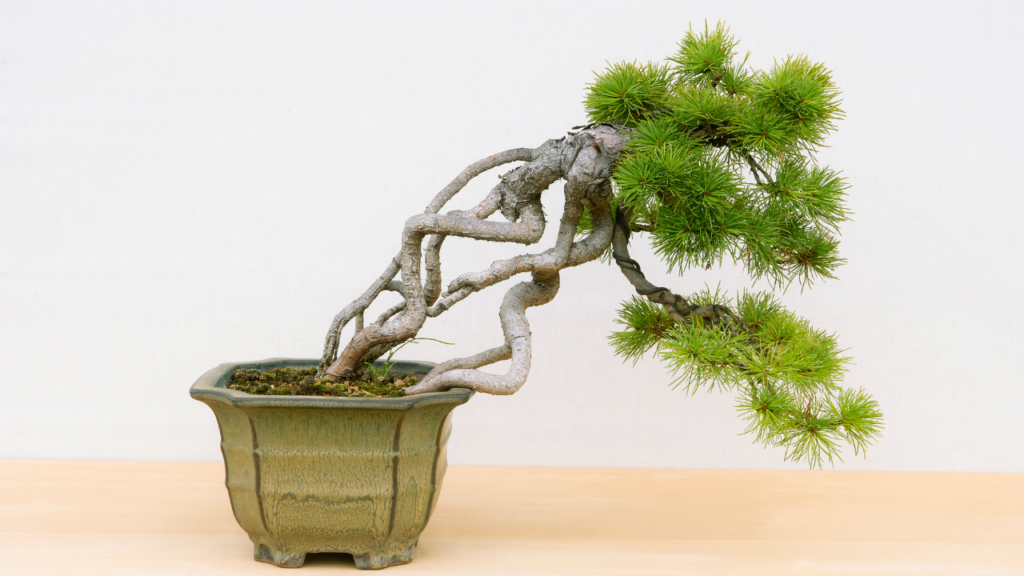
Diving Deeper into the Shakan Style of Bonsai
A unique form within the Bonsai art, the Shakan style, better known as the slanting bonsai, involves the deliberate tilting of the tree to accomplish a slanting trunk. Derived from Japan, “Shakan” translates to the “slanting style,” and is symbolic of the endurance of nature and the perpetual struggle of trees against the environment. Shakan style bonsai are notably characterized by their structure and balance; it’s not just a tree leaning to one side. There’s a harmonious interaction between the trunk, branches, and roots. The leaning angle, the direction of the tilt, and the overall unity of the tree create an aesthetic that is uniquely Shakan.
The Elegance of Shakan Style Bonsai Trees
Shakan styled bonsai trees highlight the beautiful conflicts and survival strategies present in nature. By being tilted to one side, these trees showcase a natural reaction to elements like wind, snow, or landslides. Yet, despite the slant, there is a distinct sense of balance in the tree, much like a dancer in the mid of a performance. The leaning trunk, carefully pruned branches, and robust root system create an interesting and dynamic visual spectacle.
Inspirational Shakan Style Bonsai Examples
Take, for example, the famous Shakan style Hinoki Cypress (Chamaecyparis obtusa) housed in the Omiya Bonsai Art Museum in Japan. This tree leans at a dramatic angle, with layered branches creating a rich, verdant canopy. The combination of sharp tilt and heavy foliage gives a striking impression of strength amid adversity.
Another remarkable example is the Shakan style Japanese White Pine (Pinus parviflora) found in the National Bonsai & Penjing Museum in Washington, D.C. With its twisted and gnarled trunk leaning elegantly, the tree gives a visage of age and refinement.
Finally, a stunning Shakan style Juniperus Chinensis “Blaauw”, exhibited at the Bonsai San show in France, captures attention with its sharply angled trunk, piercing foliage, and spread-out branches, all of which exhibit the classic charm of the Shakan style.
Why Shakan Style Bonsai Trees are a Favorite Amongst Bonsai Artists
Many bonsai artists are drawn to the Shakan style due to its dynamic nature and the creativity it allows. The tilting of the trunk gives artists the freedom to showcase the tree’s growth and struggle, while the asymmetry provides a sense of movement and visual contrast. While there’s a formal aesthetic rule guiding the formation of these bonsai with a strict 60-80 degree angle, the elegance and grace of Shakan style trees appear vividly in several interpretations and stylizations by different artists.
Shakan Style: A Symbol of Grace Under Pressure
In the bonsai world, Shakan style is more than just an aesthetically pleasing form. It’s a symbol of resilience, indicating how nature adapts and thrives in the face of adversity. Each slant, each bend, and each twist tells a story of survival, rendering these trees not just visually stunning, but also deeply meaningful.
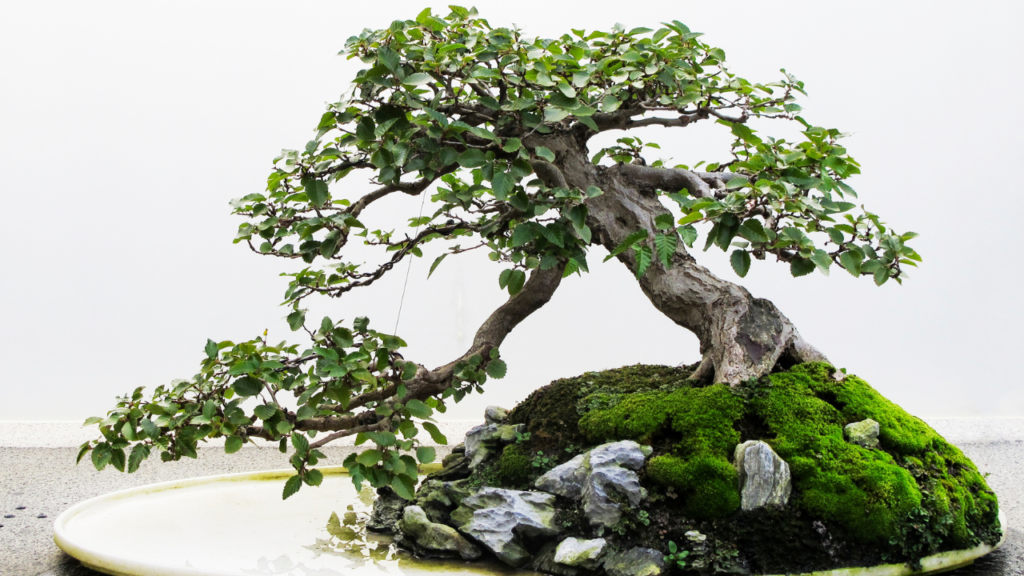
Indeed, the Shakan style bonsai, with its strikingly slanting form, is both a testament to the strength and resilience of nature and a mirror of the meticulous care and craftsmanship of the bonsai enthusiast. Understanding its aesthetic basis, learning the craft of shaping the tree, and applying the necessary care are integral to appreciating the true essence of this bonsai style. With a diverse range of tree species to choose from and numerous stunning examples worldwide to inspire from, the journey to mastering the Shakan bonsai style is filled with depth, fascination, and rewarding challenges.
